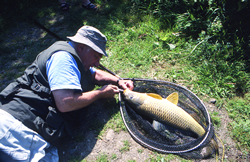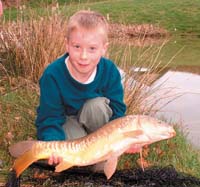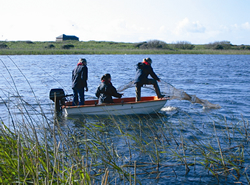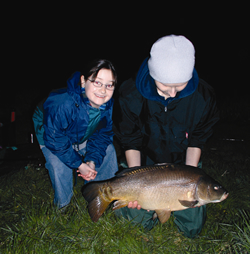The Bristol Avon flows from its twin sources near Sherston and Tetbury to its confluence with the River Severn at Avonmouth and travels some 117 kilometres in total (72 miles). The river has five major tributaries, the Rivers Marden, Somerset Frome, Chew, Bristol Frome and the By Brook. All provide excellent coarse fishing although the By Brook is mostly controlled by private syndicates so it is not available to the average angler.
Most waters in the area are controlled by local angling clubs and membership must be obtained before fishing. Club membership can usually be purchased from local tackle shops. There are some sections of the river in Malmesbury, Bath, Saltford, Keynsham and Bristol that are considered "free fishing". These sections of the river are mostly owned or controlled by local authorities and not leased to angling clubs. It is important to note that a valid Environment Agency rod licence is also required when fishing any of these waters; licences can be obtained from all post offices as well as from local Environment Agency offices.
Malmesbury, a picturesque old Cotswold market town with its 12th century Abbey as its' focal point, is the uppermost point on the Avon open to the coarse angler. Although fishing is difficult when the water is clear it has produced roach and perch of over 3lb and carp of 20lb plus in the past two seasons.
From Malmesbury the river meanders its way downstream to the market town of Chippenham and has many weirs that provide impounded sections above weirs, with riffle and pool below. Barbel, chub and roach predominate in the faster water giving way to large bream shoals just upstream of Chippenham town. Notable catches include a five hour match record of 140lb of bream. Individual records include a monster pike of over 33lb and the almost unbelievable tench of 12lb 7oz caught by Rick Seal from Cardiff in the river at Christian Malford in November 1998.
Downstream of Chippenham town centre "free fishing" extends from the weir to the bypass road bridge (fishing the right hand bank) and then transfers to the left hand bank downstream to and including Mortimers Wood. This section is some 1.25 miles in length and contains good quality fish. Most notably barbel to 12lb, chub to 4½lb, bream to 7lb, tench to 4lb, perch to 2lb and pike to 18lb.
Further downstream at Lacock, the river passes by this National Trust village, best known for its Abbey and as the home of early photographer Fox-Talbot, and onto Melksham which is dominated by the Avon Tyre factory (now owned by Coopers of America). Match weights vary from 2lb to 12lb on the upper reaches to perhaps 60lb on the lower reaches near Melksham (if the bream are feeding!).
Onward to Staverton, then Bradford on Avon with its tythe barn, old church and antique shops (a must for tourists), Avoncliffe and Limpley Stoke. All have large impoundments above their weirs. Here fish can be a little more difficult to locate but large bream shoals are here to be found and caught. The liberal use of ground bait, an open ended feeder with a hook bait of red maggot, worm or caster usually does the trick. One place not to be missed after a hard day's slog on the river bank is the Cross Guns Public House at Avoncliffe — well known by the locals for its good beer and steaks at a reasonable price. Below Avoncliffe are the Limpley Stoke and Claverton weirs, nestling within a scenic valley, where wooded sides rise in places, some 300 feet above. In these sections where the water runs faster and is quite weedy in the summer months, lie the haunts of very large barbel. The best captured so far, nearly 15½lb weight, is very close to the national rod caught record. Most other species can also be caught with good roach, dace, chub, tench, perch and bream. Also, it is not unusual for the pike angler to capture specimens of 12-20lb with the best reported fish of 26lb caught by Gary Court at Claverton in 1988.
The city of Bath with its Roman Baths and internationally renowned Georgian architecture provides a scenic backdrop to over 2.5 miles of "free fishing". Below Pulteney Weir hot water spills into the river from the Roman Baths, which provides interest for carp of over 20lb. Individual anglers have reported superb roach catches of over 30lb, just upstream of North Parade Bridge and 40lb plus nets of chub, taken on caster at Widcombe. Another hot spot near Windsor Bridge produces large quantities of bream, with individual fish weighing over 7lb in weight. It makes this particular stretch well worth consideration.
The river below Bath becomes slower and boat usage more intense. Newbridge, Saltford and Keynsham provide excellent match stretches where individual weighs vary from 2 to 20lb with roach, chub, bream and eels predominating. There are further "free" sections at the Shallows in Saltford and a small area 200 yards downstream of Keynsham weir on the far side of the roadbridge.
At Hanham the "free fishing" extends on the right hand bank through Conham Park to Netham Weir some 3.5 miles in total. Conham Park has a car park, toilets and facilities for the disabled. Fishing on this stretch is quite good with mixed nets of dace, roach, chub, perch and eels. From Netham to the river's confluence with the River Severn at Avonmouth, the river becomes an estuarine environment with one of the largest tide variations in the world. Near Netham Weir some coarse fish can still be caught together with the occasional mullet and flat fish.
Bristol has numerous attractions, few more inviting, for the angler, than the sight of a large expanse of water. The City docks, also known as the Floating Harbour, is a large area, and situated in the centre of the City. This, together with its connection to the main river, the Feeder Canal, provides a venue with numerous swims for the match and pleasure angler. Permits are available both on the bankside and from tackle shops or the Harbour Masters Office, situated near the restored SS Great Britain. The Docks have an average depth of 15 feet. Roach, dace, bream and perch can be caught in good numbers with carp or chub as a bonus. Most fish are caught using an open ended feeder with a hook bait of maggot, bread, worm or sweetcorn. In the summer months fish tend to feed off the bottom more, float fished baits presented at a depth of 3 to 6 feet can produce good catches.
Most barbel fishing is upstream of Bath, popular venues being Warleigh, Limpley Stoke, Avoncliffe, Lacock, Chippenham, Peckingell, Kellaways and Christian Malford. Any of these venues offer the realistic prospect of a double figure barbel. Legering with large bait such as meat, flavoured paste or lob worm will often bring results, though this approach generally works best when the river is coloured. In hard fished areas or in clear water conditions, try using particle baits like maggots or sweetcorn, which can be put down with a bait dropper or fished in a feeder. Hemp will usually get fish feeding, but in some areas barbel have become wary of feeding on hemp. Experimenting with different baits and techniques is often the key to catching barbel consistently. Where permitted, fishing large baits after dark is without doubt the best way to target the larger fish. It is best to return barbel to the water as soon as possible, avoiding the use of keepnets. They can become exhausted when caught, particularly in hot weather, and should be supported in the flow until they regain strength to swim away.
The Kennet and Avon Canal, a navigation built to join the rivers Thames and Bristol Avon, was opened in 1810. After years of neglect in the 1950s and 1960s, work started on its restoration. Now some 30 years later and with many millions of pounds spent, the canal is nearly restored to its former glory. In North Wessex, our area commences at Horton just east of Devizes. From
Horton it winds its way through Devizes and drops down the spectacular Caen Hill flight of 29 locks to Sells Green, Semington and onwards to Bradford on Avon, Limpley Stoke and Bath where it joins with the River Avon, a distance of approximately 25 miles. The canal will provide the angler with plenty of sport, particularly during the summer months, with favoured swims for large carp in the ponds below Devizes.
Most species can be caught throughout the canal's length with roach, rudd and bream falling to float fished punched bread with small balls of liquidised bread used as an attractant. Tench, crucian carp, perch and eels can be tempted with red worm, maggot or caster used as hook bait. Small amounts of chopped worm or pinkies added to the ground bait keep their interest. Remember to stake your keepnet securely to the bank or it may be carried away by a passing boat. Also please remember that walkers and cyclists are entitled to use the tow path and you must not obstruct them with fishing tackle, rod or pole. The Waterways Code is available from all Waterways Offices.
There are more than 100 lakes and ponds in the North Wessex area for the angler to take advantage of. Some are managed by syndicates, others privately owned and available to fish on day tickets. Lakes such as Sevington, a small village on the outskirts of Chippenham, Erlestoke near Devizes, Longleat (a series of lakes in the grounds of Lord Bath's Estate) and Ivy House Lakes at Grittenham in the Wootton Bassett area provide good coarse fishing. Trout fishing is also catered for with large lakes like the nationally renowned Chew Valley Lake and smaller venues like Mill Farm at Great Cheverell. There are many lakes and ponds run by angling clubs such as Newton Park which are available through Bathampton AA membership. Bristol, Bath and Wiltshire AA has Shackells, Sword and Sabre lakes. Both clubs have other larger facilities, two of which are:
Tockenham Reservoir near Lyneham lies just three miles from M4 intersection 16 via the A3102. This beautiful 12.5 acre lake, surrounded by oak woodland, was created in 1836 to provide water for the Wilts and Berks Canal. Purchased by Bristol, Bath and Wiltshire AA in 1980 it has since been developed into a magnificent fishery stocked with carp to 30lb, tench to 7lb, bream to 8lb, plus roach, perch and crucian carp. All fishing is from platforms, including three purpose built for the wheelchair disabled, and there are good parking facilities.
Bathampton AA's Hunstrete Lakes are situated 7 miles west of Bath. They comprise a mature 5 acre lake plus two newly constructed lakes of 3.5 acres. These are set in 21 acres of landscaped grounds and provide picturesque and tranquil surroundings with provision for 120 swims. The main lake contains carp to 28lb, tench to 7lb, pike to 20lb and plenty of other fish to maintain your interest. The new lakes, Bridgepool and Withypool, have been recently stocked with over £30,000 worth of fish, with carp to 5lb, bream to 4lb, roach to 2lb, plus perch, crucian carp and chub. Car parking and toilets are provided with facilities for the disabled, including 15 purpose built platforms.
Please remember that as an angler you are an ambassador for the sport. It is important to remove all litter and discarded line from your swim and return all fish to the water with the utmost care.
 When I started fishing over half a century ago, carp had an almost mythical quality. Carp fisheries were few and far between – and when you found them their inhabitants had a reputation for being almost impossible to catch.
When I started fishing over half a century ago, carp had an almost mythical quality. Carp fisheries were few and far between – and when you found them their inhabitants had a reputation for being almost impossible to catch.

 The European Eel (Anguilla anguilla) is an incredibly important, but often under-valued fish species in the Atlantic Area. It is essential to the economic viability of many small-scale coastal fishing communities in Europe as well forming part of the traditional fishing economy in the UK.
The European Eel (Anguilla anguilla) is an incredibly important, but often under-valued fish species in the Atlantic Area. It is essential to the economic viability of many small-scale coastal fishing communities in Europe as well forming part of the traditional fishing economy in the UK. Coarse fishing has spawned a huge variety of baits, both natural and 'unlikely'. Some of these, and the species you are likely to catch, are listed below.
Coarse fishing has spawned a huge variety of baits, both natural and 'unlikely'. Some of these, and the species you are likely to catch, are listed below. It was with some trepidation that I decided to return to coarse angling after a break of some 20 years. What had sparked this renewed enthusiasm was partly the fact that my son had taken up the sport following a holiday in France and was pestering for someone to take him fishing. My own return has led me to realise just how difficult it is to get back into the sport and how daunting it must be for new people wanting to give it a try.
It was with some trepidation that I decided to return to coarse angling after a break of some 20 years. What had sparked this renewed enthusiasm was partly the fact that my son had taken up the sport following a holiday in France and was pestering for someone to take him fishing. My own return has led me to realise just how difficult it is to get back into the sport and how daunting it must be for new people wanting to give it a try. There are many bitter sweet experiences in the life of an angler.
There are many bitter sweet experiences in the life of an angler.